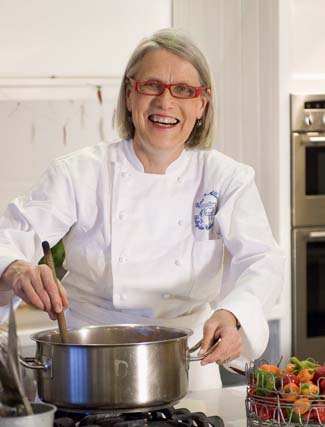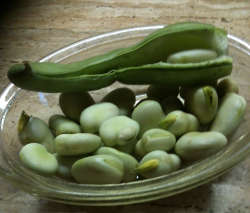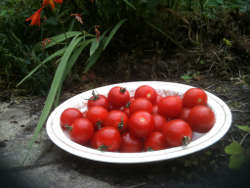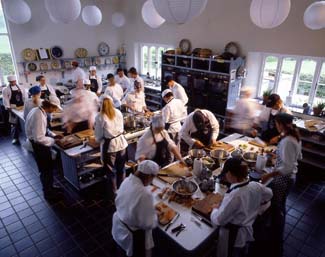The Darina Allen Column - Rooftop Farming and Backyard Chickens
 In the US something very interesting is happening, it’s virtually a grass roots revolution. However, it’s not just in the US, in cities all over the world people seem to feel a deep need to produce food locally once again. It would seem to be an international phenomenon – an eerie almost primeval reaction as if deep down people sense that there may be a shortage of food before too long.
In the US something very interesting is happening, it’s virtually a grass roots revolution. However, it’s not just in the US, in cities all over the world people seem to feel a deep need to produce food locally once again. It would seem to be an international phenomenon – an eerie almost primeval reaction as if deep down people sense that there may be a shortage of food before too long.
In fact, rooftop farming including backyard chickens and rooftop apiaries are now a major international urban trend. From Detroit to Tokyo, Rotterdam to Hong Kong, Montreal to Brooklyn, there are urban farming projects.
I first noticed the guerrilla garden movement on a visit to San Francisco about five years ago. Virtually every patch of waste ground or disused parking lot had been commandeered by eager gardeners who planted vegetables, herbs and salad leaves. Some shared their surplus with local shelters and sold the remainder from farm stands on the edge of the plot.
Since then I have visited numerous projects particularly in the US. From the Edible Schoolyard in Berkley and the City Slicker Community Farms in Oakland California, to a two acre farm in the centre of Austin, Texas. Some projects are one man bands, others community based.
Recently, I went to New York to check out the urban farming movement. For the first time I began to get idea of the sheer scale, there are over 700 urban farms and gardens across New York City alone.
Last year, I visited Brooklyn Grange a two acre rooftop farm on top of a five story building on Northern Boulevard, New York, established in May 2010.
On a recent trip, I looked at a couple of other models, a branch of Brooklyn Grange at the Navy Yard, 65,000 square feet of vegetable beds on the top of an eleven story building. This project provides a livelihood for four people, employment for a further ten people and 30 apprentices plus a refugee training program. They sell their fresh produce from a farm stand outside the building and also have a CSA (Community Supported Agriculture) and make lots of jams, pickles, hot sauces and herb teas from the surpluses and gluts from the farm.
Anastasia Cole Plakias showed me around and explained how nowadays there is growing support at government level for initiatives that are helping to change the food system plus deliver environmental benefits.
Hurricane Sandy really spooked New Yorkers particularly those in lower Manhattan and Brooklyn, some of whom were without power and water for over a week. So any initiative that contributes to storm water management (a buzz word) is welcomed and generously supported.
Anastasia explained that the Navy Yard got a generous SARE (Sustainable Agriculture, Research and Education) grant from Mayor Bloomberg and Department of the Environmental Protection who see it as more efficient to invest in green roofs and infrastructure which creates jobs and has several extra benefits. Roof top farms and green roofs not only utilise space that would otherwise be empty and unused but they absorb rain and storm water run-off that would eventually end up polluting the East River.
They also absorb heat during the day and release it into the atmosphere at night plus decrease the heating and cooling needs of a building.
The Navy Yard Project also links up with GrowNYC on a composting program. Local residents collect their organic waste which when composted enriches the fertility of the soil, which is the biggest challenge for rooftop farms.
The Edible Schoolyard started by Alice Waters in Berkeley in California now has a branch in Brooklyn which partners with schools to build gardens and kitchen classrooms where children can engage in hands-on learning. They aim to provide students with the knowledge and skills and environment required to healthier choices and change the way they eat for life.
Top chefs are also frantically growing their own produce and linking in with local projects but there is a whole other article in that of which more anon. Meanwhile, those of you who have been growing will be enjoying the fruits of your labours. Here are a few ways I have been enjoying the bounty of our gardens and greenhouse and hedgerows over the past few weeks.
Elderflower Champagne
This magical recipe transforms perfectly ordinary ingredients into a delicious sparkling drink. The children make it religiously every year and then share the bubbly with their friends.
2 heads of elderflowers
560g (11/4lb) sugar
2 tablespoons white wine vinegar
4.5L (8 pints) water
1 lemon
Remove the peel from the lemon with a swivel top peeler. Pick the elderflowers in full bloom. Put into a bowl with the lemon peel, lemon juice, sugar, vinegar and cold water. Leave for 24 hours, then strain into strong screw top bottles. Lay them on their sides in a cool place. After 2 weeks it should be sparkling and ready to drink. Despite the sparkle this drink is non-alcoholic.
Top Tip:
The bottles need to be strong and well-sealed; otherwise the Elderflower champagne will pop its cork.
Radish, Broad Bean and Preserved Lemon Salad
This Ottolenghi inspired recipe makes a delicious little starter salad on its own or with some buffalo mozzarella and pitta bread as an accompaniment.
Serves 4
500g (1lb 2oz) shelled broad beans fresh or frozen
450g (16oz) large radishes
1/2 red onion
2 tablespoons finely chopped coriander
30g (1 1/4oz) preserved lemon, finely chopped (optional)
freshly squeezed juice of 2 lemons plus zest of 1 lemon if preserved lemons are unavailable
2 tablespoons chopped flat leaf parsley
3 tablespoons extra virgin olive oil
1 teaspoon freshly ground roast cumin
salt and black pepper
2 fresh Toonsbridge buffalo mozzarella (optional)
4 fresh pitta breads
First cook the broad beans in boiling salted water (one teaspoon salt to a pint of water.) Simmer for 1 – 2 minutes, depending on size. Drain through a large colander and refresh in plenty of cold water. Slip the beans out of their skins by gently squeezing each one with your fingertips.
Cut each radish into 4 to 6 wedges depending on size. Mix with the broad beans, onion, fresh coriander leaves, diced preserved lemon or lemon zest, lemon juice, parsley, extra virgin olive oil and cumin. Season with salt and pepper. Taste and correct seasoning.
Serve soon on its own or with some buffalo mozzarella and some pitta bread as an accompaniment.
Double Lamb Chops with Sumac, Broad Beans, Melted Cherry Tomatoes and Coriander Flowers
Great with a green salad and some freekeh (Middle Eastern bulgur-like green dried wheat).
Serves 8
8 double lamb chops with cutlet bones attached
2-3 tablespoons sumac
Maldon sea salt and freshly ground black pepper
extra virgin olive oil
225g (8oz) Broad Beans (see recipe below)
Melted Cherry Tomatoes (see recipe below)
Garnish
fresh coriander flowers if available
a pinch of sumac
extra virgin olive oil
Preheat the oven to 230°C/450ºF/Gas Mark 8,
Score the fat of the chops. Sprinkle each one with sumac rubbing it well into the fat and flesh. Season with Maldon sea salt and freshly ground black pepper. Transfer to a roasting tin. Drizzle with extra virgin olive oil. Roast for 15 minutes, turn off the heat and allow to rest.
Meanwhile cook the broad beans (see recipe below). Just before serving make the melted cherry tomatoes (see recipe below).
To Serve
Pop a double lamb chop on each hot plate. Spoon some warm cherry tomatoes around the edge. Sprinkle with broad beans and coriander flowers if available. Alternatively use some shredded mint leaves. Sprinkle with a pinch of sumac and drizzle with extra virgin olive oil.
 Broad Beans
Broad Beans
Freshness is vitally important with broad beans, both flavour and texture change within hours of picking. A little summer savoury added to the cooking water enormously enhances the flavour.
Serves 6
675g (1 1/2lbs) young broad beans, out of the pods
2-3 sprigs of summer savoury (optional)
15g (1/2oz) butter
salt and freshly ground pepper
Bring 600ml (1 pint) of water to the boil in a medium saucepan and add 1 teaspoon salt and the summer savoury if using. Add the broad beans, bring back to the boil and cook for 2 -5 minutes depending on size and freshness. When cooked, taste and drain quickly tossing in a little melted butter and lots of freshly ground pepper. Serve immediately.
Note: If the broad beans are larger cook as above then drain and refresh under the cold tap until cool enough to handle. Pop each bean out of its shell then toss in hot melted butter or extra virgin olive oil. Season and serve immediately.
 Melted Cherry Tomatoes with Mint
Melted Cherry Tomatoes with Mint
Serves 8 people
40 ripe red firm sweet cherry tomatoes
3 tablespoons extra virgin olive oil or more of butter
3-4 tablespoons fresh mint
1-2 tablespoons freshly chopped rosemary
salt, pepper and sugar
Scald the tomatoes for 10 seconds and peel carefully. Just before serving, heat the butter until it bubbles in a frying pan large enough to take all the tomatoes in a single layer. Toss in the tomatoes and roll gently over a medium heat until just warmed through. Sprinkle with the herbs and salt, pepper and sugar. Turn into a hot vegetable dish and serve at once.
Note: Great care must be taken when cooking the tomatoes; otherwise they will disintegrate into a mush.
Green Gooseberry Tartlets
JR Ryall who is head pastry chef at Ballymaloe House recently showed us how to make these delicious green gooseberry tarts. His pastry recipe is also amazing but you could use puff pastry instead. Makes 36 tartlets approximately.
1 quantity cold cream pastry (see recipe below)
450g (1lb) green gooseberries (topped and tailed)
caster sugar
Preheat oven to 190°C/375°F/Gas Mark 5.
Using plenty of flour roll the cold pastry to a thickness of 2mm (1/8 inch). Cut the pastry with a 7.5cm (3 inch) round cutter and use the disks of pastry to line a standard flat based bun tray.
Cut the gooseberries in half and arrange 6-7 halves on each disk of pastry. Place a rounded teaspoon of caster sugar on top of the fruit in each tartlet. Bake the tartlets for 15-20 minutes or until the sugar begins to caramelise and the pastry is a golden brown colour. Remove the tartlets from the bun tray while still hot – use a palette knife for this – and place on parchment paper which has been sprinkled with caster sugar.
These tartlets are best served warm.
Variations
Open Apple Tartlets: Replace the gooseberries with thinly sliced eating apple.
Open Rhubarb Tartlets: Replace the gooseberries with thinly sliced pink rhubarb.
Cream Pastry
This pastry keeps in the fridge for up to 6 days.
110g (4oz) cold salted butter
110g (4oz) plain flour
150ml (5fl oz) cold cream
Sieve the flour into the bowl of an electric food mixer. Cut the butter into small cubes and rub into the flour using the paddle attachment until the mixture forms a coarse texture (slow speed and then a little faster). DO NOT over mix, if you do the mixture will form a shortbread like ball! Pour the cold cream into the coarse mixture and mix on a low speed until a smooth pastry forms. Wrap the pastry in parchment paper and chill overnight.
Always roll cream pastry straight from the fridge. If the pastry comes to room temperature it will be too soft to handle!
Rory O’Connell’s Strawberries with Lemon Basil
Serve these little flavour bombs at the end of a meal and watch the reaction – a gem of a recipe.
fresh strawberries
fresh lemon basil leaves
Just before serving, insert one lemon basil leaf carefully into the slit on the top side of a beautiful fresh strawberry. Repeat with the others. Serve immediately – a sensational combination of flavours.
***
 Once again this year, the Ballymaloe Cookery School in East Cork has a great programme of cookery courses for all interests and abilities running throughout 2013. Ranging from a relaxing visit to sit in on an afternoon cookery demonstration to a week long ‘Intensive Introductory Course’.
Once again this year, the Ballymaloe Cookery School in East Cork has a great programme of cookery courses for all interests and abilities running throughout 2013. Ranging from a relaxing visit to sit in on an afternoon cookery demonstration to a week long ‘Intensive Introductory Course’.
Sitting in the middle of a 100 acre organic farm the Ballymaloe Cookery School provides its students not only with a life skill learnt under the expert tutelage of their very capable teachers but also a place to relax and unwind from the stresses and strains of normal everyday life. The cottage accommodation available onsite for residential courses consists of a collection of delightful converted outbuildings which have been transformed over the years by the Allens, and other accommodation is available locally for the short courses.
www.cookingisfun.ie





There are currently no comments
Leave a comment
Not a member? Register for your free membership now!
Or leave a comment by logging in with: